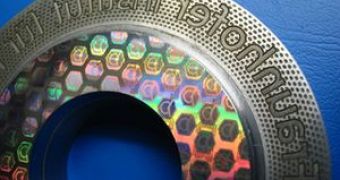Holograms are usually produced with the help of laser systems, which copy the image of a real three-dimensional object onto a photosensitive material such as Fotoresist. In doesn't mean though that only optical techniques are able to create holograms. For example, embossing holograms of steel plates with the help of lasers is practically impossible, thus researchers from the Fraunhofer Institute for Chemical Technology ICT in Pfinztal decided to give it a try through a less orthodox method.
We can find today holograms mostly anywhere, starting with banknotes, tickets and even cards, usually to protect a certain document or object from being forged. However, once embossed, it is close to impossible to copy the pattern of the hologram, as the image is created by a combination of colors and tiny structures on the surface of the object which makes light interfere and give the image a perspective of depth, or three-dimensional look. Because lasers are employed to create the detailed structures that form the image, you can imagine that the used material would have to be rather soft.
There is a way to copy the relief pattern of the hologram, but it requires nickel electroplating techniques. Once the pattern is copied, the embossing plate may be mounted on a roller to transfer the hologram image directly on plastic films, such as those seen on concert tickets.
Fraunhofer researchers, revealed that, by using a right combination of explosives, the template pattern could be easily copied on steel plates and with greater accuracy than the electroplating technique. Project manager G?nter Helferich says that the explosion method can be safely used to copy any relief image directly onto steel plates and retains it in perfect detail.
The details obtained with this method are so accurate, that the tiny holographic structures on the surface of the steel sheet can only be observed with the help of optical enhancing tools. The desired image sharpness was acquired through a whole range of experiments. Additionally, the biggest advantage of all is that the electroplating technique can finally be discarded, as nickel is too soft for holographic embossing and quickly wears out. The main goal of the study was to create a holographic copying technique to imprint holographic images on plastic parts to enhance their appearance.

 14 DAY TRIAL //
14 DAY TRIAL //